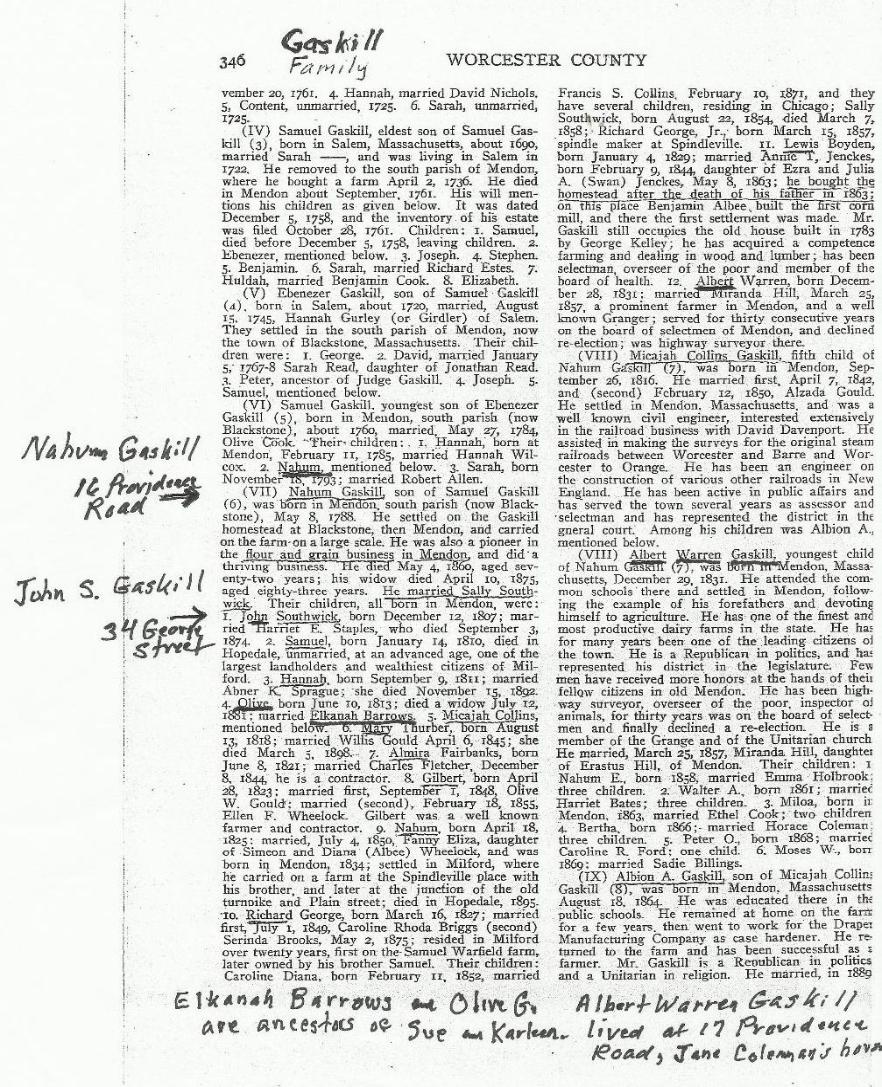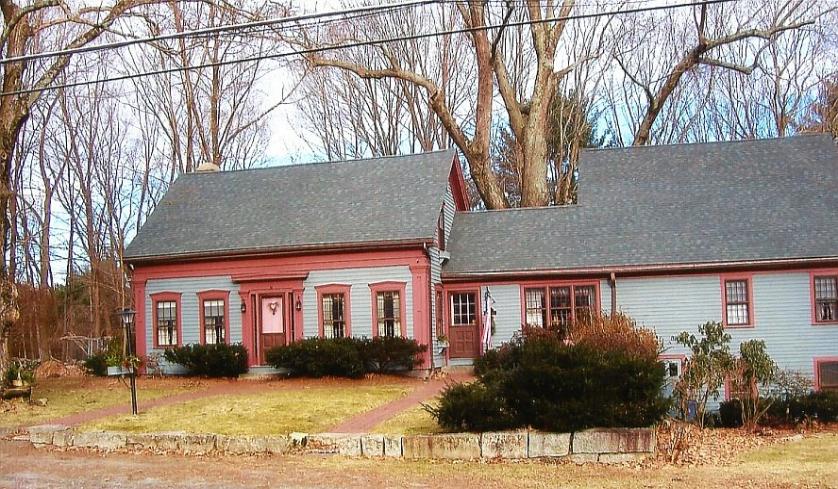
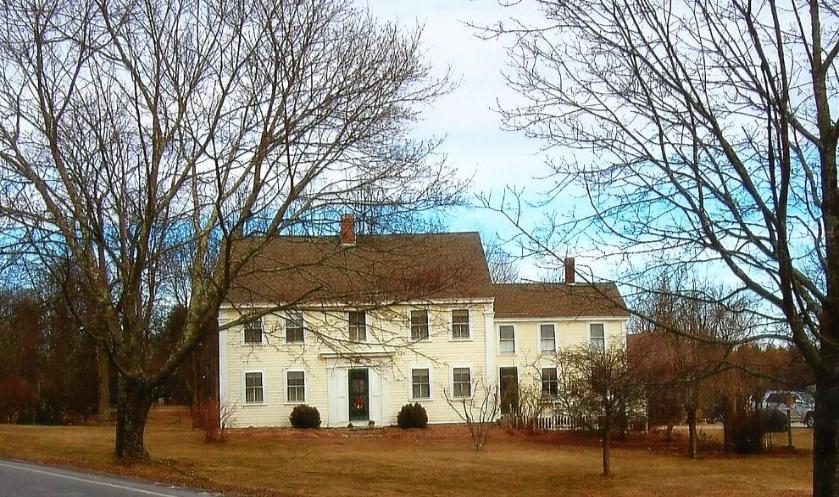
Mendon's Gaskill Family : Farmers and Public Servants
their new home at 16 Providence Road marked the beginning of change for Mendon's triangular Quaker neighborhood. The area including upper George Street, Gaskill Street, and a segment of Providence Road was the home of the town's Quaker village for over one hundred years. The emergence of the Gaskill family replaced the dwindling Quaker population by the mid 1800's, and members of the family went on to serve the town with honor and distinction in areas of agriculture and government. The Quaker religion had early roots in Mendon history. The town's founding fathers in the 1660's included George Aldrich, a Quaker. His grandson, Moses Aldrich, was born in Mendon in 1690. He became a preacher and did extensive missionary work in the colonies. In 1729, his associates constructed a Friends Meeting House on George Street, and services were held there regularly. By 1757, there were twenty-six Quakers listed in Mendon. Moses died in 1761 and was buried in the Friends Cemetery. Services ended in 1841, and the meeting house was sold to Israel Plummer of Northbridge in 1850. He dismantled it and used the wood to construct a train depot near his granite quarry adjacent to Plummer's Corner. The Gaskill family grew and prospered in an agricultural way of life. . Sally and Nahum raised twelve children at 16 Providence Road. Nahum also operated a very successful grain and flour business. As the children became adults, they had become skillful farmers. They were offered land to build their own homes and establish their own farms. The oldest son, John, was a selectman and a highway commissioner. He married Harriet Staples. They built, or possibly inherited, a farmhouse near Muddy Brook, at what is now 34 George Street. Successful farming operations took place there for generations. Their daughter, Julie, married Arthur Viets Pond. Their children were Arthur, Anna, and Clara Pond. Micajah built his home at 16 George Street. Besides being a farmer, he was also a highly regarded civil engineer, who designed plans for railroad construction throughout New England. He served as a selectman, an assessor, and a state representative. Albert and his wife, Miranda Hill, built a Queen Anne style home at 17 Providence Road. He was regarded as one of the finest and most productive dairy farmers in the state. He was an active member of the National Grange. He also served as a selectman for thirty years, a highway surveyor, an overseer of the poor, and a state representative. His daughter, Bertha, married Horace Coleman, and his son, Peter, married Caroline Russell Ford, granddaughter of Ambassador Jonathan Russell. Albert was an outstanding farmer and public servant. Other members of the Gaskill family included Gilbert, who lived at 13 Blackstone Street. He was a well known farmer, town official, and contractor. Olive married Elkanah Barrows. Their family continued a long standing legacy of excellence in agriculture. Members of the Gaskill family represented what was best about Mendon in the 1800's. Their work ethic, which they learned at their homestead at 16 Providence Road, prepared their focus on farming and public service. They were the essence of the town's culture and economy. They were tillers of the soil. Richard Grady February 11, 2013 More on the Gaskill family Mendon Menu |
Nahum and Sally Southwick Gaskill home - Providence Road |
Micajah Gaskill home - George Street |
John Southwick Gaskill home - George Street |
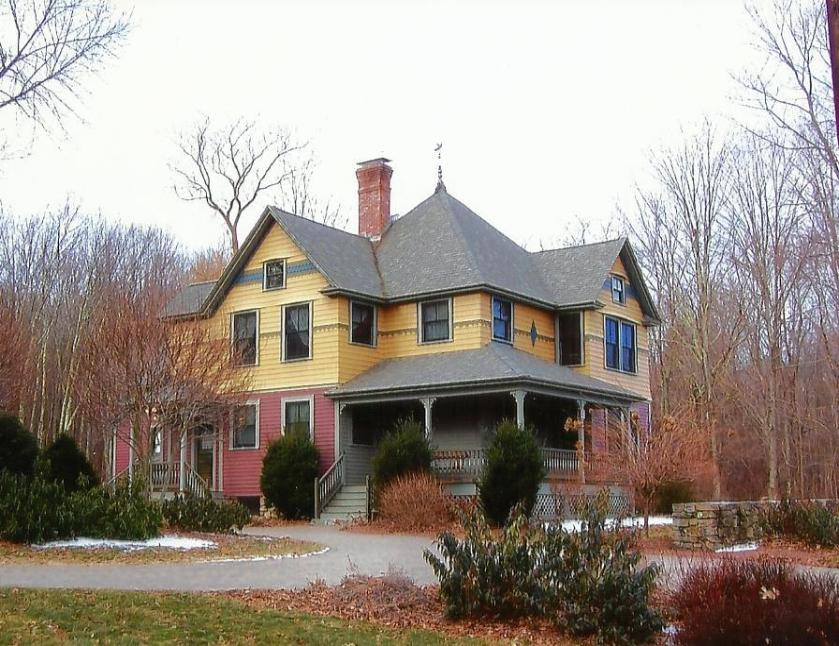
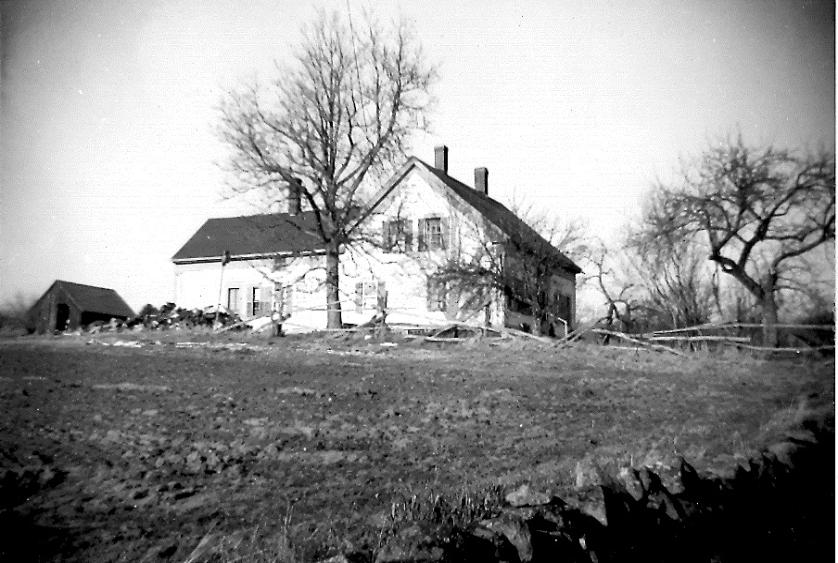
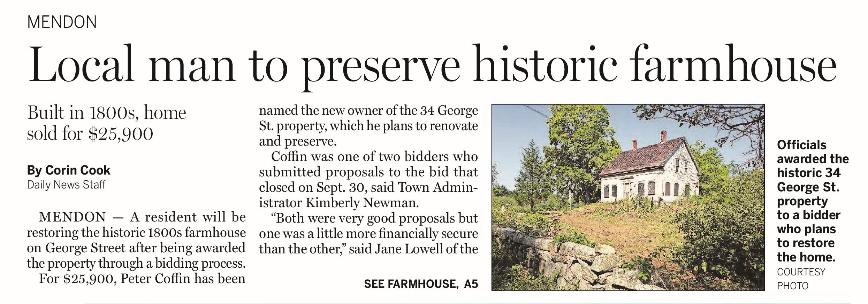
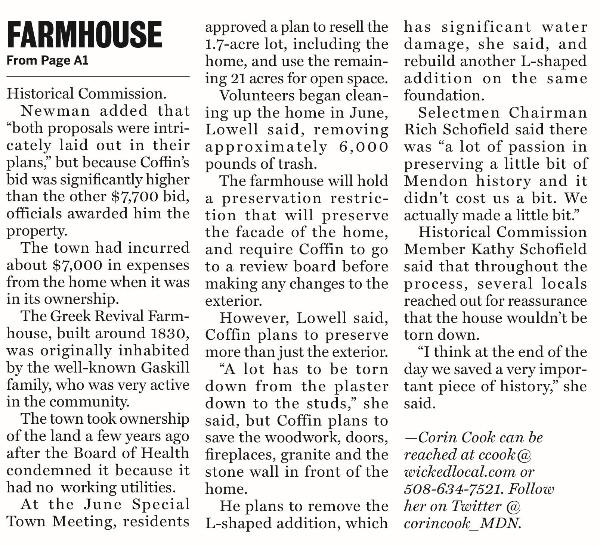
This Milford Daily News article published on October 19, 2016 refers to the house shown in the second picture on this page. |
The Quaker Farmhouse at 34 George Street The age-worn farmhouse at the lower end of George Street adjacent to Muddy Brook has reflected the changes in the relevance of agriculture in Mendon's economy and society since its construction in the early 1830's. Once part of a robust Quaker Village of hard working farmers, 34 George Street and the people who have lived there have echoed the changes in Mendon's reliance of making a living by farming. The village was a few hundred yards south of the Mendon center. It included George and Gaskill Streets and the upper part of Providence Road. It was inhabited by Gaskills, Aldriches, and Southwicks. The Quaker neighborhood was part of Mendon's earliest history. George Aldrich, one of the town's founders, settled here in the 1660's. His grandson, Moses Aldrich, was born here in 1690. He became a preacher and did missionary work throughout the colonies. In 1729, a Friends Meeting House was built at the Quaker Cemetery on George Street. There were twenty-six Quakers listed as living here in 1757. The village grew in an agricultural way of life, but it was the settlement of a new family that had a significant impact on the neighborhood. Nahum and Sally (Southwick) Gaskill built a new farmhouse at 16 Providence Road. They raised twelve children who left a positive impact on the village and town. John Southwick Gaskill and Harriet (Staples) Gaskill built, or possibly inherited, a low key New England farmhouse nestled in the verdant pasture next to the brook at 34 George Street. They were hard working farmers and productive citizens. John served as selectman, overseer of the poor, representative to the General Court, and road commissioner. Besides being skillful farmers, all the Gaskill siblings were involved in public service. They were highly regarded and well thought of in the Mendon community. Julia Gaskill, daughter of John and Harriett, married Alexander Viets Pond, and they continued successful farming at 34 George Street. They had three children who grew up on the farm: Arthur, Clara, and Anna Pond. They never married, and as they grew older, and inherited the farm, they became well aware of the challenges of adapting to change. By the 1950's, the Pond family farm had declined to just a few cows and chickens, an aging house, and the realization that they had become elderly with no family heirs to maintain the farm. Elaine Holt, whose family lived on George Street near the Pond family in the 1950's, has pleasant recollections of the house and the people. She and her husband, Dan Malloy, are historians who live in Hopedale. She gave a vivid account of life at the Pond farmhouse from her childhood memories.. Elaine described the kitchen as having an old soapstone sink with no faucet, just a hand pump. There were open shelves, and on the bottom shelf, a wooden bucket was kept. She recalled asking for a drink of water and being handed the bucket and a dipper. She said that the water was wonderful! The living room had a player piano with several piano rolls being stored on shelves of a corner cabinet. The dining room area had a rocking chair and a new refrigerator. Elaine thought that it was unusual that the new appliance was not used to refrigerate food, but to make ice cubes for the ice box. It was evident that Anna, Clara, and Arthur were reluctant to let go of ways of the past. The farmhouse at 34 George Street is a reminder of a thriving agricultural, Quaker neighborhood of the 1830's. Since that time period, many changes have taken place. The last Quaker service was conducted in 1841. The Friends Meeting House was dismantled in 1850, and the wood was sold to Israel Plummer of Northbridge for his train depot. The occupation of farming in Mendon gradually declined as the real estate market focused on farmland. The elderly Pond family passed on. Their farm was left to their very kind and helpful neighbor, Norman Cox, who had been their farmhand. Though change has taken place all around it, the age worn, weather beaten farmhouse has remained in a time period of the past. It is a symbol of a way of life long ago, when farming was the essence of Mendon's culture. Mendon Historical Society -- June 26, 2016 More information may be obtained by going to The Pond and Cox Families of Mendon by Elaine (Holt) Malloy. |
